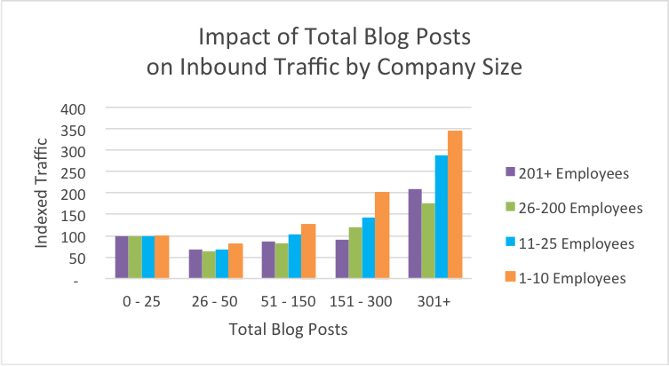How To Plan Quality Content For Your Small Business Part 1

Seventy percent of B2B businesses are creating more content this year than they did last year. And with consumers spending 50% of their time online engaging with custom content, it’s no surprise why.
By now, you probably know that content marketing is here to stay. However, content creation and publishing is an expensive investment—one that you may not feel you can afford. This is especially true when you look at the enormous resources large corporations pump into their own content marketing efforts. If you are a small business working on a small business budget, how can you compete? Well, don’t count yourself out of the game just yet.
You may not have hundreds of thousands of dollars to devote to marketing, but that doesn’t mean you can’t throw your hat in the content ring too. Though you will have to invest time and money into your content, there are ways to make each marketing dollar (and piece of content) stretch farther. Here’s how:
Identify Your Goals
With all the hullabaloo raised in the marketing world (and for good reason) about the necessity for content production, it might seem like a huge budget and multiple posts per day are essential for a successful content campaign. I have good news for you: They’re not. As with many things in life, the end goal should focus more on quality rather than quantity.
And how do you measure quality? A few ways. But perhaps the most important is whether or not your content efforts help you achieve your goals. In order to measure that, you need to have some goals in the first place.
So, before you start planning out your editorial calendar and hiring a team of writers, figure out what it is you want your content marketing campaign to achieve.
Here are a few questions you could ask yourself: 
- Do I want our content to primarily generate leads?
- Do I want to establish greater brand recognition with specific audiences?
- Am I looking to increase sign ups or subscriptions?
- Do I want to become a trusted authority?
- Am I simply hoping to build SEO value on my site?
- Am I looking to achieve all the above?
Your specific goals should reflect your overarching business objectives. Because at the end of the day, if your content isn’t helping you achieve your business goals, it isn’t helping you at all. And if you’re a small business with a small budget, you can’t afford to invest in campaigns that don’t give you returns.
Therefore, figure out which outcomes you’re looking for. Then you can build your specific strategy around them. Develop a Strategy
Develop a Strategy
Once you have some goals in mind for your content, you can start outlining a strategy to achieve those goals. I could write a whole post on how to develop a content strategy (stay tuned), but here are just a few basic things you should consider:
Budget
As a small business, you likely don’t have unlimited funds and resources to devote to your campaign. (If you do, then you probably don’t need to read this post.) So, the first thing you need to do is determine a budget. How much time and money do you want (and can you afford) to invest in your content marketing? This number is obviously going to vary dramatically from business to business, based on your overall financial resources, as well as the manpower you have to devote to your campaign.
Ask yourself the following questions to identify how your budget will be allocated:
- Will I be producing content in-house from a designated team, or will I outsource to freelancers or an agency?
- Do I want a wide breadth of content types? Or will I focus on just one or two channels? Infographics, eBooks, white papers, and social posts are all going to vary in production costs.
Keep in mind that working with an agency will often be the most expensive option because they typically work with freelance networks and mark up costs as the middle man. Though the advantage is that this will save you the time of hiring freelancers and managing the content production process, this is an area you could save on by doing it yourself.
Publishing Frequency
Once you have an outlined budget, decide how often you want to produce and publish content. Will you publish 3 posts a day, one post a week, or ten posts a month? Keep in mind that frequency is less important than consistency. If you only have the time or money for one or two full posts a week, that’s fine! Producing content consistently over time is much more effective for increasing audience engagement and establishing authority than spewing out dozens of posts one week and nothing the next. However, do keep in mind that the more content you can afford to produce, the higher your returns will be. As you can see from the Hubspot graphs below, traffic and leads grow exponentially in direct relation to the number of published posts you produce. 

Whether you’re publishing only a handful of posts per month, or dozens, every bit counts. The key is to stay consistent so that you build up your store of content and indexed posts; that way, eventually you’ll have hundreds of pages for Google to track and for customers to engage with. And as you can tell from these graphs, when you reach the 300-400 post range, both leads and site traffic tend to skyrocket.

Even if you are planning to write the content yourself, one 300-500 word blog post can be completed in under an hour. So if you can find just one or two hours a week to write, that’s one to two pieces of content you can share every week!
(Though these graphs reflect numbers based on blog post publication, the basic principles will still apply to other pieces of content. Whether you focus more heavily on eBooks, email campaigns, or social profiles, the more you engage and the more useful your content—in any form—the more returns you’re going to see over time.)
Target Audience Personas
One of the most important pieces of your content strategy puzzle is your target audiences. You likely already have several customer personas outlined for your general marketing and business plans. Use these to hone in on what kind of content these customers are looking for and where they go to get it. Figure out who they are, where they spend their time and gather their information (e.g. television, radio, social media, blogs etc.), what concerns they have, and how you can help. There’s no reason to invest a lot of time and money into a Twitter profile if your audience primarily turns to their email or Facebook.
Build content that your customers want; make sure it answers their questions and provides value. You can have a beautifully designed infographic with great copy, but it won’t help you if it isn’t useful for your customers.
Type of Content
Finally, decide what type of content you are going to produce, based on your budget, target audience, and publishing frequency. There are many forms of content, not all of which will be well suited to your goals, audience or industry. Here are just a few options to consider:
- Blog posts
- Emails
- White pages
- Infographics
- Facebook posts
- Twitter posts
- Pinterest pins
- Video (e.g. YouTube)
- Audio (e.g. Podcasts)
- Case studies
- Customer reviews and testimonials

Content is essentially any consumable information. The more valuable or useful that information is, whether in text, image, or audio format, the more effective it will be at engaging customers and generating returns for your business.
It will take time to figure out which channels work best for you—you may even find that the best solution is a combination of two or more types of content. And luckily, many of these channels go hand-in-hand naturally. For instance, if you create a blog post, it’s easy to share it on your Facebook or Twitter profiles. Suddenly, that’s three platforms on which to get face time with your customers, all with one original post.
There are so many options in content marketing that it can be daunting for small businesses to jump in the game. However, don’t let the wide variety of choices hold you back. Pick just one or two channels to work on and stick with those for a while—always making sure to track your progress and measure your success in those areas. If you aren’t seeing results after a couple months, reevaluate and tailor your approach.
Once you have your general strategy in place, it’s time to figure out how you can make your content dollars go farther for you. Be on the lookout for Part 2 to see how!

Good Blog Briitney ! I do think is very important to have good relevant and informative content on the website! Creating copy for my client’s websites is something that I like to do the most.
It is so important to establish business goals before creating a business strategy, Love this article, great job.
I love this list of “Types of Content” at the end. Businesses need to know the different resources they have to create and post content for their business. Most think of “words” and do not realize that pictures, video, and sound play a role as well.
True! Do you have anything you would add to the types of content list?
I think surveys and polls are good when applicable. It is interactive and it allows the company to gather data at the same time.
Do you have a favorite survey/poll/quiz service?
In the past Survey Monkey and Google Forms have served me well. I love how both compile data.